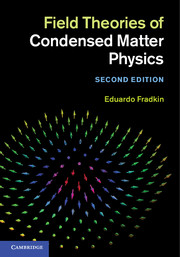Book contents
- Frontmatter
- Contents
- Preface to the second edition
- Preface to the first edition
- 1 Introduction
- 2 The Hubbard model
- 3 The magnetic instability of the Fermi system
- 4 The renormalization group and scaling
- 5 One-dimensional quantum antiferromagnets
- 6 The Luttinger liquid
- 7 Sigma models and topological terms
- 8 Spin-liquid states
- 9 Gauge theory, dimer models, and topological phases
- 10 Chiral spin states and anyons
- 11 Anyon superconductivity
- 12 Topology and the quantum Hall effect
- 13 The fractional quantum Hall effect
- 14 Topological fluids
- 15 Physics at the edge
- 16 Topological insulators
- 17 Quantum entanglement
- References
- Index
7 - Sigma models and topological terms
Published online by Cambridge University Press: 05 March 2013
- Frontmatter
- Contents
- Preface to the second edition
- Preface to the first edition
- 1 Introduction
- 2 The Hubbard model
- 3 The magnetic instability of the Fermi system
- 4 The renormalization group and scaling
- 5 One-dimensional quantum antiferromagnets
- 6 The Luttinger liquid
- 7 Sigma models and topological terms
- 8 Spin-liquid states
- 9 Gauge theory, dimer models, and topological phases
- 10 Chiral spin states and anyons
- 11 Anyon superconductivity
- 12 Topology and the quantum Hall effect
- 13 The fractional quantum Hall effect
- 14 Topological fluids
- 15 Physics at the edge
- 16 Topological insulators
- 17 Quantum entanglement
- References
- Index
Summary
Generalized spin chains: the Haldane conjecture
The phenomenology which emerges from the spin one-half Heisenberg antiferromagnetic chain is quite striking: there is no long-range order, and there are gapless states, in particular, gapless spinless fermions (which, in the Heisenberg picture, are solitons). From the point of view of the Hubbard model, the Heisenberg model occurs at infinite coupling, where the charge-bearing degrees of freedom acquire a gap that is infinitely large. Thus spin and charge degrees of freedom are separated and the spin sector is at a critical point. This phenomenology inspired Anderson, (1987) to propose a similar picture for the two-dimensional systems, the resonating-valence-bond (RVB) picture. However, most of this picture surely should not generalize. Critical points are not generic and, in general, it is not possible to have gapless states without the spontaneous breaking of a continuous symmetry except in one dimension due to the Mermin–Wagner theorem. In higher dimensions gapless states without a broken symmetry may be possible in a Coulomb phase of a gauge theory with a continuous gauge group. Thus, the 1D spin one-half case may be more the exception than the rule. For instance, it may be possible that the system is in a state without long-range order, which is likely to be massive. For this reason, it is important to consider generalizations of the Heisenberg model. This problem has been studied extensively. Two different approaches have been considered in one dimension: (a) enlarging the representation (higher spin, same symmetry group SU(2)) and (b) higher symmetry groups (SU(N), for instance).
- Type
- Chapter
- Information
- Field Theories of Condensed Matter Physics , pp. 189 - 250Publisher: Cambridge University PressPrint publication year: 2013



